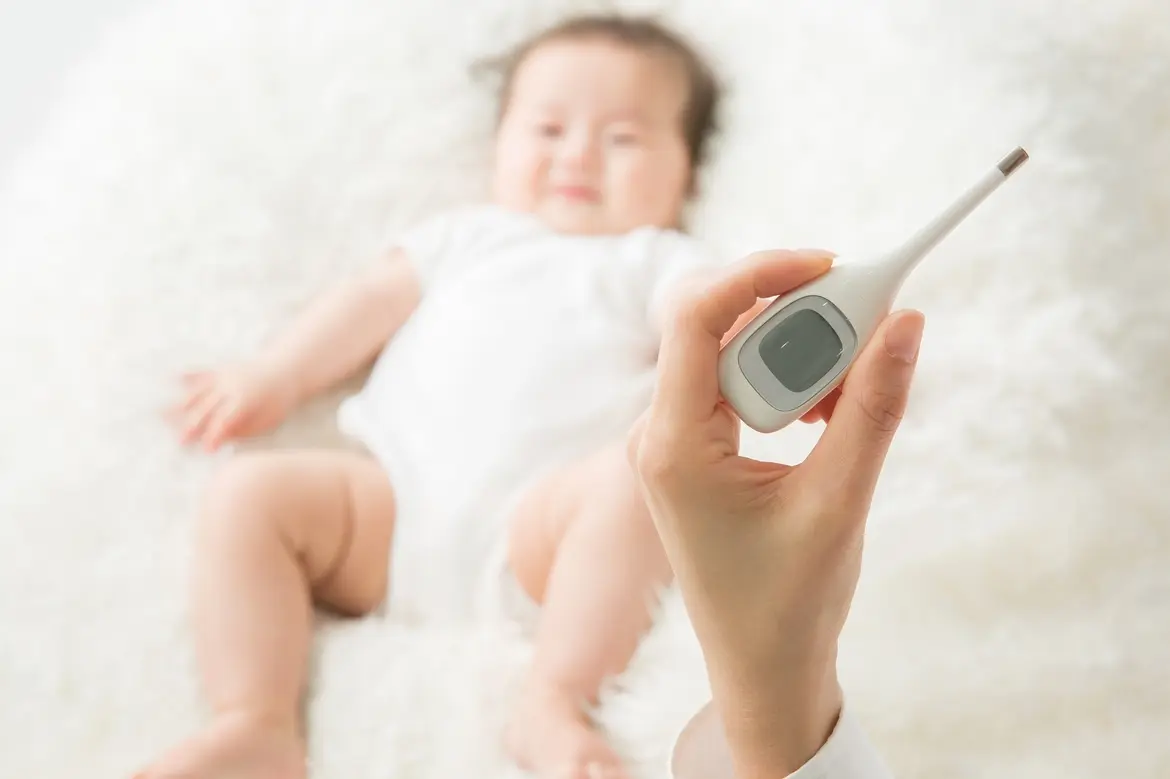-
-
Khu vực chăm sóc và điều trị


Nguồn: Shutterstock
Sốt ở Trẻ Sơ Sinh: Khi Nào Bạn Nên Lo Lắng?
Cập nhật lần cuối: 03 Tháng Chín 2020 | 2 phút - Thời gian đọc
Nhận câu trả lời cho những câu hỏi thường gặp về sốt ở trẻ sơ sinh, và học cách đo nhiệt độ cơ thể và xử lý tình trạng của trẻ sơ sinh.
Nhiệt độ nào được coi là sốt ở trẻ sơ sinh?
Thông thường, nhiệt độ cơ thể bình thường của bé phải duy trì từ 36.5°C đến 37.5°C. Bất kỳ chỉ số nào trên 38°C được coi là sốt.
Khi nói đến sốt ở trẻ sơ sinh, điều tốt nhất bạn có thể làm là chuẩn bị sẵn sàng. Khi bé không khỏe, sốt thường là dấu hiệu đầu tiên của vấn đề. Sốt thường là dấu hiệu cho thấy hệ thống miễn dịch đang chống lại bệnh tật hoặc nhiễm trùng.
Một số điều cần lưu ý về sốt ở trẻ sơ sinh:
- Quấn quá nhiều hoặc môi trường nóng có thể khiến nhiệt độ cơ thể bé tăng cao
- Mức độ cao của sốt không chỉ ra mức độ nghiêm trọng của bệnh gây ra sốt
- Hầu hết sốt ở trẻ em do nhiễm trùng virus, có thể kéo dài từ 5 – 7 ngày
Làm thế nào để đo nhiệt độ của trẻ sơ sinh?
Có nhiều phương pháp khác nhau để đo nhiệt độ của trẻ sơ sinh. Cách tốt nhất để có kết quả chính xác cho trẻ dưới 3 tuổi là sử dụng nhiệt kế hậu môn số. Nhiệt kế tai, trán và nách cũng tiện lợi nhưng không chính xác bằng.
Khi nào nên gọi bác sĩ nhi khoa cho trẻ sơ sinh dưới 3 tháng tuổi bị sốt?
Hãy gọi bác sĩ nhi khoa nếu bé dưới 3 tháng tuổi và bị sốt trên 38°C. Sốt kéo dài hơn 5 ngày là một vấn đề đáng lo ngại.
Khi nào nên gọi bác sĩ nhi khoa cho trẻ sơ sinh trên 3 tháng tuổi bị sốt?
Hãy chú ý đến các triệu chứng và hành vi của bé để xác định mức độ bệnh tật, và hỏi ý kiến điều trị từ bác sĩ dựa trên những dấu hiệu đó. Sốt thường biến mất trong vòng 3 – 5 ngày nhưng bất kể tuổi của trẻ, sốt kéo dài là một vấn đề đáng lo ngại.
Nếu bạn thực sự lo lắng, và nếu sốt của bé đi kèm với các triệu chứng sau, hãy đưa đến phòng cấp cứu ngay lập tức hoặc gọi xe cứu thương:
- Trông bệnh tật, buồn ngủ hoặc không phản ứng
- Khó thở
- Có phát ban không mờ đi dễ dàng
- Cổ cứng, đau đầu nặng hoặc co giật
- Khóc không an ủi được
- Nôn mửa liên tục có mật hoặc máu
- Chỗ lõm trên đỉnh đầu (fontanelle) phồng ra
- Tiếng khóc yếu, cao và khác thường
Trong trường hợp khẩn cấp y tế ở Singapore, bạn cũng có thể gọi +65 6473 2222 để xe cứu thương đưa bạn đến bệnh viện gần nhất hoặc bệnh viện bạn chọn. Tìm hiểu thêm về dịch vụ cấp cứu của Parkway.
Fever In Children. Retrieved August 1, 2018 from https://www.nhs.uk/conditions/fever-in-children/Your Pregnancy and Baby Guide. Retrieved August 1, 2018 from https://www.nhs.uk/conditions/pregnancy-and-baby/how-to-take-your-babys-temperature/
Infant And Toddler Health. Retrieved August 1, 2018 from https://www.mayoclinic.org/healthy-lifestyle/infant-and-toddler-health/in-depth/thermometer/art-20047410
Taking Baby's Temperature. Retrieved August 2, 2018 from https://www.webmd.com/baby/taking-babys-temperature
Taking Your Child's Temperature. Retrieved September 19, 2018 from https://www.parents.com/health/fever/taking-your-childs-temperature/
Fever In Infants and Children. Retrieved September 19, 2018 from https://www.cfpc.ca/ProjectAssets/Templates/Resource.aspx?id=3596
Fever In Babies: 7 Things You Might Not Know. Retrieved September 19, 2018 from https://www.babycenter.com/0_fever-in-babies-7-things-you-might-not-know_10373598.bc
Infant And Toddler Health. Retrieved August 1, 2018 from https://www.mayoclinic.org/healthy-lifestyle/infant-and-toddler-health/in-depth/thermometer/art-20047410
Taking Baby's Temperature. Retrieved August 2, 2018 from https://www.webmd.com/baby/taking-babys-temperature
Taking Your Child's Temperature. Retrieved September 19, 2018 from https://www.parents.com/health/fever/taking-your-childs-temperature/
Fever In Infants and Children. Retrieved September 19, 2018 from https://www.cfpc.ca/ProjectAssets/Templates/Resource.aspx?id=3596
Fever In Babies: 7 Things You Might Not Know. Retrieved September 19, 2018 from https://www.babycenter.com/0_fever-in-babies-7-things-you-might-not-know_10373598.bc









